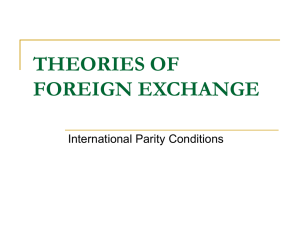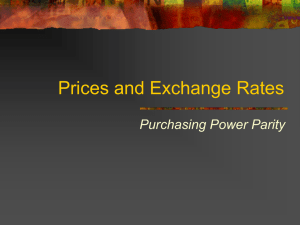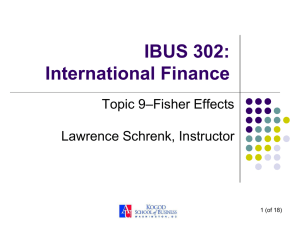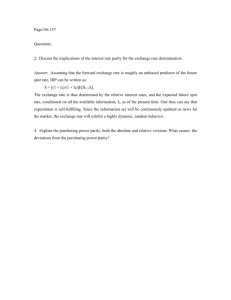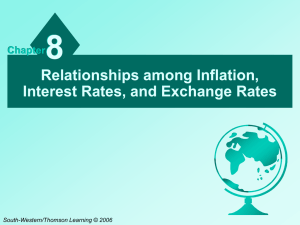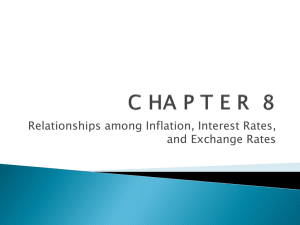Parity Conditions in International Finance
advertisement
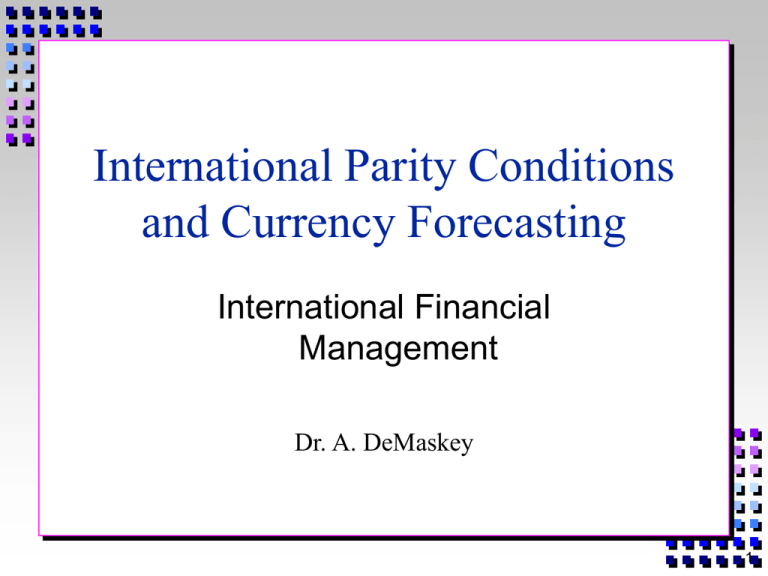
International Parity Conditions and Currency Forecasting International Financial Management Dr. A. DeMaskey 1 Learning Objectives What is the “law of one price?” How does arbitrage link goods prices and asset returns internationally? What are parity conditions and why should we study them? What currency forecasting techniques can be used under a fixed versus a floating rate system? 2 What are Parity Conditions? Parity Conditions Pricing relationships based on the law of one price Hold if no arbitrage opportunities exist Law of One Price Identical products should sell for the same price everywhere Otherwise, arbitrage opportunities will exist Arbitrage Profit-guaranteeing strategy of “Buy low, sell high” No investment and no risk 3 Why Study Parity Conditions? They provide the foundation of international finance. They are useful in: Explaining the determinants of foreign exchange rates. Forecasting the long-run trend in an exchange rate. 4 International Parity Conditions Purchasing Power Parity (PPP) Absolute PPP Relative PPP Fisher Effect (FE) Generalized Fisher Effect (GFE) International Fisher Effect (IFE) Interest Rate Parity (IRP) Unbiased Forward Rate (UFR) 5 Purchasing Power Parity Absolute PPP Asks what should be the current exchange rate Is based on price levels Relative PPP Asks how the exchange rate should change Is based on price changes 6 Absolute PPP Application of the “law of one price” to national price levels The foreign exchange rate is given as: The law of one price is stated as: 7 The Big Mac Hamburger Standard The Economist developed the Big Mac Standard to track PPP: Assuming that the Big Mac is identical in all countries, it serves as a comparison point as to whether or not currencies are trading at market prices Big Mac in Switzerland costs Sfr6.30 while the same Big Mac in the US costs $2.54 The implied PPP of this exchange rate is However, on the date of the survey, the actual exchange rate was Sfr1.73/$ 8 How Well Does the Absolute PPP Work? Based on the assumption of free trade It has limited usefulness due to: Differentiated goods Costly information Transportation costs Differential tariffs, quotas, and other restrictions on free trade Thus, the Relative PPP is more commonly used today because is has more reasonable assumptions 9 Relative PPP The exchange rate change is equal to: Parity in the new foreign and domestic price index is stated as: Relative PPP states that: 10 Simplified PPP PPP can be approximated as: PPP states that currencies with high rates of inflation devalue relative to currencies with low rates of inflation. 11 Nominal versus Real Exchange Rates Nominal exchange rate Price of one currency in terms of another Real exchange rate Real purchasing power of one currency relative to another PPP and real exchange rates If an exchange rate adjusts fully to the inflation differential according with PPP, the real exchange rate remains constant. PPP holds if real exchange rates are stable over time. 12 Real Exchange Rate Quoted exchange rate adjusted for the country’s inflation rate. The real exchange rate is equal to: 13 How Well Does Relative PPP Work? PPP does not hold over the short-run Sticky goods prices (lagged changes) Changes in exchange rates precede changes in prices. PPP holds over the long-run Clear relationship between relative inflation rates and changes in nominal exchange rates PPP holds more closely when price indices cover tradable goods. PPP holds better in high-inflation cases. 14 Fisher Effect Describes the relationship between the nominal interest rate, real interest rate, and the inflation rate. Fisher equation: 15 Simplified FE The Fisher Effect can be approximated as: The nominal rate equals the real rate plus inflation. 16 Generalized Fisher Effect GFE says that real rates are equal among countries. GFE states that currencies with high rates of inflation should bear higher interest rates than countries with lower rates of inflation. 17 How Well Does the FE (GFE) Work? The FE (GFE) generally holds. However, real interest rate differentials exist due to: Currency risk Inflation risk Political risk » Differing tax policies » Regulatory barriers to free flow of capital 18 International Fisher Effect Similar to Relative PPP except it uses interest rate rather than inflation rate differentials to explain exchange rate changes. The effective return on a home bank deposit is equal to: The effective return on a foreign bank deposit is equal to: 19 International Fisher Effect Equality in effective return on a home and foreign investment is stated as: The IFE states that: 20 Simplified IFE The IFE can be approximated as: IFE states that currencies with low interest rates should appreciate relative to currencies with high interest rates. 21 How Well Does IFE Work? Lend some support to IFE. Nominal interest rate equals real interest rate plus expected inflation. If real interest rate increases, the nation’s currency appreciates. If expected inflation increases, the nation’s currency depreciates. Considerable short-run deviations do occur. Uncovered interest arbitrage 22 Interest Rate Parity Spot and forward rates are related by IRP Relative returns on domestic and foreign investment: IRP states that: 23 Interest Rate Parity (IRP): Example Suppose you have $1 million to invest for 90 days and the following choices: Invest in dollar-denominated securities for 90 days earning 8.00% per annum, or Invest in Swiss franc-denominated securities of similar risk and maturity earning 4.00% per annum Suppose you have the following quotes: Spot rate of SF1.4800/$ 90-day forward rate of SF1.4655/$ Would you invest in the U.S. or Switzerland? 24 Covered Interest Arbitrage Spot and forward market are not in equilibrium. Relative forward differential does not equal relative interest differential. 25 Generalization of Covered Interest Arbitrage If: If: (1 i d ) (1 i f )f1 e0 (1 i f )f1 (1 i d ) e0 26 How Well Does IRP Work? Small deviations from IRP do occur. Covered interest arbitrage opportunities Lack of arbitrage profit opportunities due to: Transactions costs Differential tax rates Government controls Political risk Time lag 27 Unbiased Forward Rate Interest rate differential Unbiased nature of the forward rate f1 = E(e1) Market efficiency does not require that f1 = E(e1) 28 Are Forward Prices Unbiased? Evidence that forward rates are biased predictors of future spot rates. Risk premium » Appears to change signs » Averages near zero Market efficiency It appears that it does pay to use resources to forecast exchange rates. 29 Currency Forecasting Successful currency forecasting is difficult. Currency forecasting can lead to consistent profits only if forecaster has: Superior forecasting model Access to information before other investors Exploit small, temporary deviations from equilibrium Ability to predict government intervention in foreign exchange market 30 Forecasting Fixed Exchange Rates Forecasters must focus on predicting government action, since devaluations and revaluations are political decisions. Basic forecasting methodology involves: Determine pressure on a currency to devalue or revalue Determine political will of leaders to persist with current level of disequilibrium 31 Forecasting Floating Exchange Rates Market-Based Forecasts Forward rate Interest rate Model-Based Forecasts Fundamental analysis Technical analysis 32 Parity Conditions Theory Purchasing power parity (PPP) Key Variables of Theory Percentage change in spot exchange rate International Fisher effect (IFE) Interest rate parity (IRP) Summary of Theory Interest rate differential Forward rate premium (or discount) 33 International Parity Conditions FE Interest Rate Differential (1 ih ) (1 i f ) Expected Inflation Rate Differential E (1 I h ) E (1 I f ) IFE IRP Forward Differential f1 e0 PPP Expected Change in Spot Rate e1 e0 UFR 34

